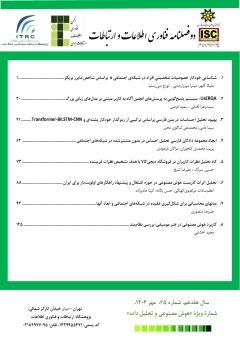شناسایی خودکار خصوصیات شخصیتی افراد به کمک پست های آنها بر اساس شاخص مایرز بریگز
محورهای موضوعی : AI and Roboticsملیکا کلهر 1 , ميترا ميرزارضايي 2 * , تورج بنی رستم 3
1 - گروه مهندسي کامپیوتر،واحد علوم و تحقیقات، دانشگاه آزاد اسلامي،تهران،ایران
2 - گروه مهندسي کامپیوتر،واحد علوم و تحقیقات، دانشگاه آزاد اسلامي،تهران،ایران
3 - گروه مهندسي کامپیوتر، دانشگاه آزاد اسلامي، ،واحد تهران مرکز، تهران،ایران
کلید واژه: شبکههای اجتماعی, شخصیت شناسی, مایرز بریگز, یادگیری عمیق, برت,
چکیده مقاله :
شخصیت افراد، مجموعهای از رفتارها و شیوه تفکر آنها در محیط اجتماعی و زندگی روزمره است. روانشناسان به طور معمول از پرسشنامههای شخصیتی برای تعیین شخصیت افراد استفاده میکند. افزایش دسترسی به دادههای اجتماعی آنلاین، علاقه محققان را به مطالعه روشهای محاسباتی پیشرفته برای روانشناسی شخصیت مبتنی بر متن برانگیخته است که روشی نوظهور با پتانسیل بالا در زمینه شناسایی شخصیت است. در این مقاله بکمک شاخص مایرز بریگز و استفاده از دادههای شبکه اجتماعی X تلاش شده تا مشخص شود چگونه میتوان از ردپای دیجیتال افراد برای پیشبینی شخصیت آنها استفاده کرد. این مقاله از معماری یادگیری عمیق چند مدلی شامل برت و روبرتا، و ایکس ال نت که معماریهای نسبتا جدیدی در پردازش زبان هستند، استفاده نموده است. در این مقاله از مدلهای ذکر شده برای استخراج ویژگی و تشخیص شخصیت افراد بر اساس شاخص مایرز بریگز استفاده شده است. در نهایت، سیستم بر اساس میانگینگیری نتایج مدلها تصمیم گیری می کند. روش پیشنهادی، یک مدل پیشبینیکننده برای هر صفت شخصیتی را با استفاده از ویژگی های مستخرج از مدلهای از پیش آموزش دیده تولید می کند. نتایج نشان می دهد که این روش به دقت ۸۸.۵% و امتیاز اندازه گیری اف یک ۰.۸۸۲ دست یافته است. این پژوهش زمینه ای را برای توسعه سیستم شناسایی شخصیت فراهم می کند که می تواند به سازمان ها در استخدام و انتخاب پرسنل مناسب و همچنین بهبود روابط تجاری با مشتریان کمک نماید.
Personality traits are a collection of behaviors and way of thinking in social environment and daily life. Psychologists usually use personality questionnaires to determine personality types. The increasing availability of online social data have stimulated researchers' interest in the study of advanced computational methods for text-based personality identification. Personality identification by computational and machine learning models based on text is an emerging phenomenon with high potential. In this article, the personality of people based on the Myers Briggs index has been investigated and analyzed using Twitter data. To investigate how text-based digital footprints can be used to predict users' personalities, a multi-model deep learning architecture along with three pre-trained language models Bert , Roberta, and XLNET, which are relatively new architectures in language processing are employed for extracting features from people's posts in X social media for identification of personality traits. the final decision is make via model averaging. The proposed model generates a predictive model for each personality trait. The results obtained shows an accuracy 88.5% and an F1-measure score of 0.882. This work provides a basis for the development of a personality trait identification system that can help the organizations to recruit and select the right personnel and improve its business by knowing the personality and preferences of its customers.
[1] Majumder, Navonil and Poria, Soujanya and Gelbukh, Alexander and Cambria, Erik, "Deep Learning-Based Document Modeling for Personality Detection from Text," IEEE Intelligent Systems, vol. 32, pp. 74-79, 03 2017.
[2] Xue, Di and Hong, Zheng and Guo, Shize and Gao, Liang and Wu, Lifa and Zheng, Jinghua and Zhao, Nan, "Personality Recognition on Social Media With Label Distribution Learning," IEEE Access, vol. 5, pp. 13478-13488, 2017.
[3] J. Š. Matej Gjurković, "Reddit: A Gold Mine for Personality Prediction," in Proceedings of the Second Workshop on Computational Modeling of People's Opinions, Personality, and Emotions in Social Media, New
Orleans, Louisiana, USA, 2018, pp. 87-97. [4] Faidh Ilzam Nur Haq and Erwin Budi Setiawan, "Implementasi Naive Bayes Classifier untuk Prediksi Kepribadian Big Five pada Twitter Menggunakan Term Frequency-Inverse Document Frequency (TF-IDF) dan
Term Frequency-Relevance Frequency (TF-RF)," vol. 6(2), p. 9785–9795, 2019. [5] Sandhya Katiyar, Sanjay Kumar, Himdweep Walia, "Personality Prediction from Stack Overflow by using Naïve Bayes Theorem in Data Mining," International Journal of Innovative Technology and Exploring Engineering
(IJITEE), vol. 9, no. 3, pp. 1555-1559, 2020. [6] Tomas Mikolov and Wen-tau Yih and Geoffrey Zweig, Linguistic Regularities in Continuous Space Word
Representations, NAACL, 2013. [7] David M. Blei & Andrew Y. Ng & Michael I. Jordan , "Latent dirichlet allocation," The Journal of Machine
Learning Research, vol. 3, p. 993–1022, 2003. [8] Kishan Das,Himanshu Prajapati, "PERSONALITY IDENTIFICATION BASED ON MBTI DIMENSIONS USING NATURAL LANGUAGE PROCESSING," International Journal of Creative research Thoughts, vol. 8(6), pp. 1653-1657,
2020. [9] Kazemeini, Amirmohammad and Fatehi, Samin and Mehta, Yash and Eetemadi, Sauleh and Cambria, Erik,
"Personality Trait Detection Using Bagged SVM over BERT Word Embedding Ensembles," 07 2020. [10] Kamal El-Demerdash and Reda A. El-Khoribi and Mahmoud A. and Sherif Abdou, "Deep learning based
fusion strategies for personality prediction," Egyptian Informatics Journal, vol. 23, pp. 47-53, 2022. [11] Sakdipat Ontoum, Jonathan H. Chan, "Personality Type Based on Myers-Briggs Type Indicator with Text
Posting Style by using Traditional and Deep Learning," CoRR, vol. abs/2201.08717, 2022.

